Omega Reconfigured
This phase can be broken down into three sections:
Transition
This is the only phase in the fight with a transition mechanic.
[Click to Expand] Transition debuffs
 | Sniper Cannon Fodder Four players will be targeted with this debuff.
|
 | High-powered Sniper Cannon Fodder Two players will be targeted with this debuff (which leaves two players without any debuffs).
|
| 1. Line up horizontally. All players will need shields to survive the transition. | 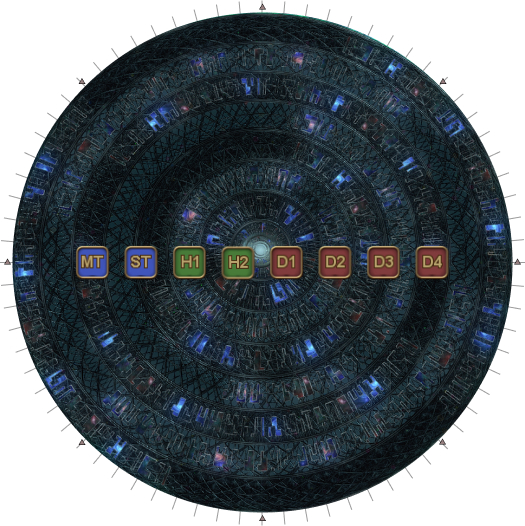 |
| 2. Debuffs appear.
|  |
| 3. First pulse of an expanding Wave Repeater AoE goes off. Three arms will appear around the arena, 120 degrees from one another. Note where these first set of arms are. |  |
| 4. Second pulse goes off. The second set of arms will appear around the arena. |  |
| 5. Third pulse goes off. Note: The Wave Repeater AoE boundaries do not follow the rings on the floor. | 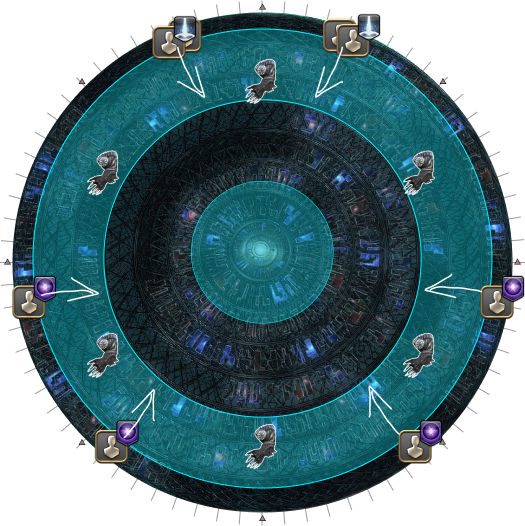 |
| 6. Fourth pulse goes off. At this point, all players should be in position for the second wave of mechanics. | 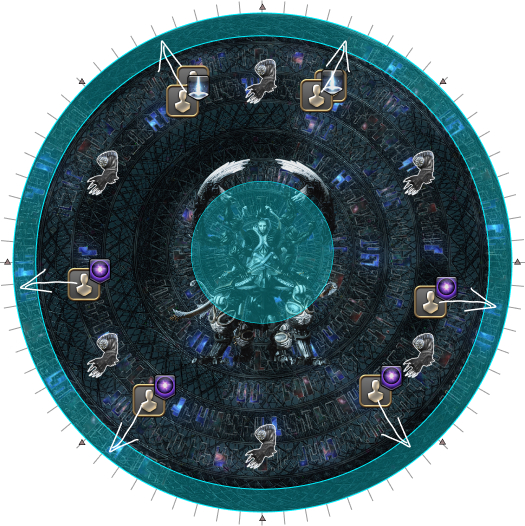 |
| 7. First pulse of the second wave goes off. | 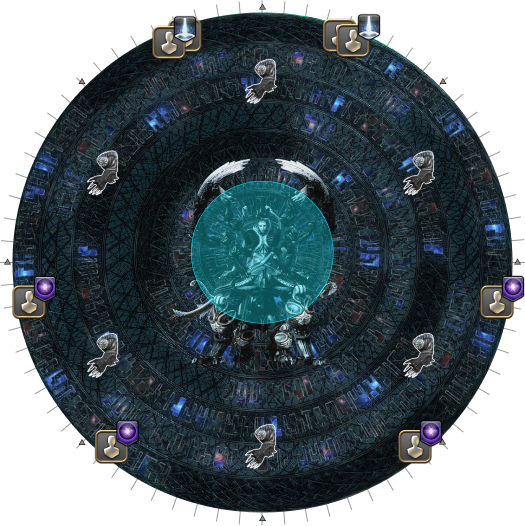 |
| 8. Second pulse of the second wave goes off. The first set of arms will telegraph an AoE around them. | 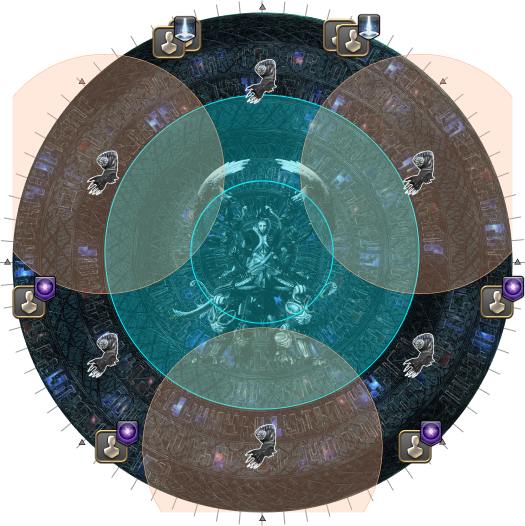 |
| 9. Third pulse of the second wave goes off. The first set of arms explode, while the second set of arms telegraph their explosion. Move into the intersection of the expanding pulse and the first set of AoE so you do not get hit by the second set of arms. | 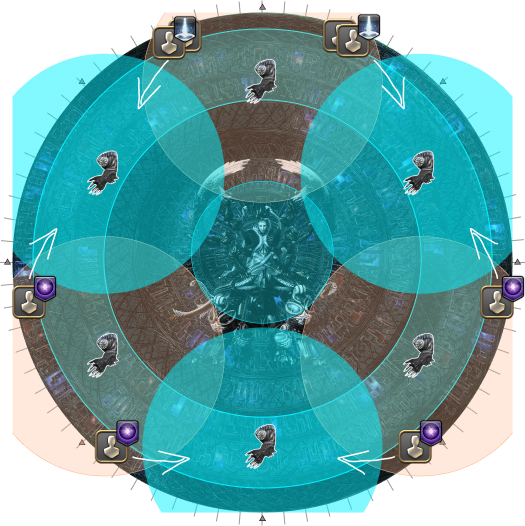 |
| 10. Player debuffs resolve along with the second set of arm's AoE. | 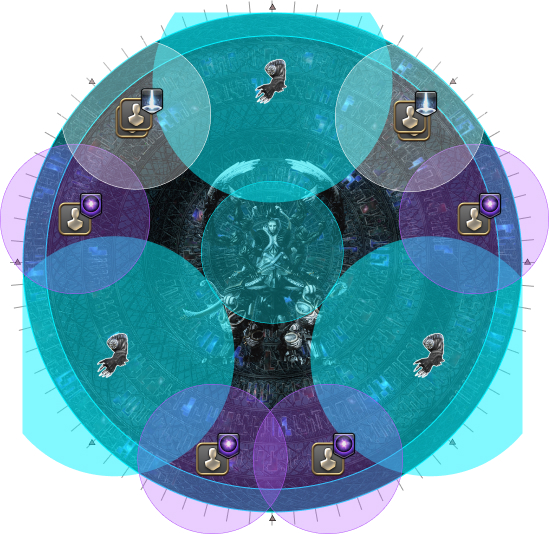 |
Hello, World
Omega begins the phase with its signature Hello, World mechanic, which does raid-wide damage, and applies a lot of debuffs on all players.
[Click to Expand] Hello, World debuffs
 | Latent Synchronization Bug
|
  | Local Code Smell
Local Regression
|
  | Remote Code Smell
Remote Regression
|
  | Cascading Latent Defect
Latent Performance Defect
|
   | Overflow Code Smell
Critical Overflow Bug
Overflow Debugger
This last detail is important, because Omega will cast Critical Error at the end of all four iterations, which will apply a Critical Overflow Bug on the entire party (which will then be blocked by everybody's Critical Overflow Debuggers). |
   | Synchronization Code Smell
Critical Synchronization Bug
Synchronization Debugger
|
   | Underflow Code Smell
Critical Underflow Bug
Underflow Debugger
|
   | Performance Code Smell
Critical Performance Bug
Performance Debugger
|
Although Hello, World may look overwhelming, only two things are relevant:
- What colour “Nisi” (Critical Performance and Critical Underflow) is paired with Critical Overflow and Critical Synchronization. This is determined when the debuffs appear, and will be fixed for the entire phase.
- What debuff you currently have in the cycle (the Local/Remote Regression tethers, or the Critical Overflow/Synchronization “Nisis”).
These two rules then determine where everyone goes each loop:
- Critical Overflow/Synchronization (the “Nisis”)
- Players with Critical Overflow (the “Defamations”) always take their coloured tower, standing towards the outside.
- Players with Critical Synchronization always take their coloured tower, standing towards the inside.
- Local/Remote Regression (the tethers)
- Players with the red/green tethers always stretch their tether, and stand beside the players with Critical Overflow (the “Defamations”)
- Players with the blue tethers always stand in between the players with Critical Synchronization.
This then puts the party into one of the two formations below, depending on whether Critical Overflow is paired with Critical Performance or Critical Underflow.
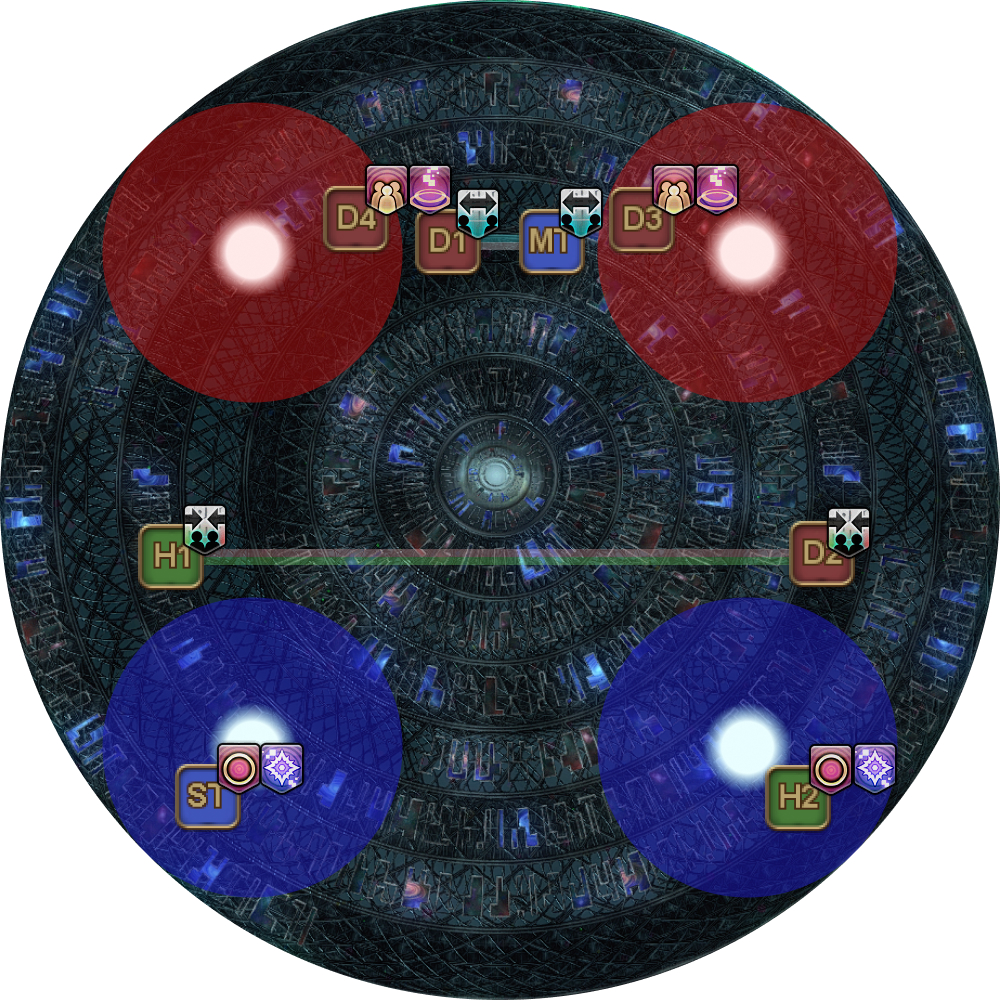 |  |
| "Blue is Defamation" Critical Overflow | "Red is Defamation" Critical Overflow |
When the Critical Overflow/Synchronization Bugs resolve, everyone in the party takes damage, and we pass the Critical Performance/Underflow (“Nisis”) debuffs by having the tether players move to the players with Critical Performance/Underflow.
The tethers will also become real, which we then resolve one by one:
- First, break the blue tethers by having those players move away from each other (this will naturally break when picking up Critical Performance/Underflow).
- Then, break the red/green tethers by having those player move towards each other.
Thus, the full Hello, World sequence goes like this:
| 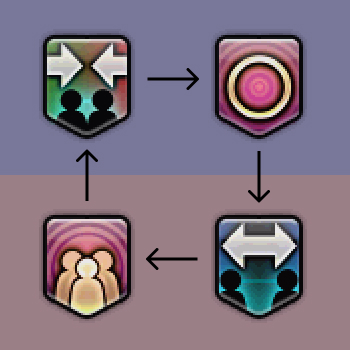 |
Once all steps have been completed, the party will find itself with different debuffs to resolve, and the sequence repeats.
This loop is repeated four times (all players will have their go at each debuff). However, the final iteration has one small difference where the Local Regression players stand with the Critical Synchronization Bugs instead.
Mitigation
One last thing to touch on will be party mitigation.
Each loop, the party will take raid-wide damage from the Critical Overflow/Synchronization debuffs resolving, and the two tethers breaking.
The party needs three pieces of mitigation (shields count) to survive all the damage from each loop without any healing in between.
As a baseline, I recommend the following mitigation:
[Click to Expand] Mitigation Notation
| Party mitigations | |
| MT 90s, ST 90s | Shake It Off, Dark Missionary, Heart of Light, Divine Veil |
| H1 120s | Temperance, Neutral Sect |
| H2 30s | Sacred Soil, Kerachole |
| H2 90s | Deployment Tactics, Zoe |
| H2 120s | Expedient, Holos |
| D1, D2 | Feint |
| D3 | Troubadour, Tactician, Shield Samba |
| D4 | Addle |
| Hello, World |
|
| First loop |
|
| Second loop |
|
| Third loop |
|
| Fourth loop |
|
| Critical Error |
|
Each of these will need the party topped to full, and something else from the healers, whether it be Succor/Eukrasian Prognosis, Sacred Soil/Kerachole, Liturgy of the Bell/Macrocosmos, etc.
Omega will also auto-attack the tanks in between loops, which should be mitigated to alleviate strain on the healers. Consider tank-swapping around the third set of towers to cycle through both tank’s cooldowns.
We can now (finally) go over Hello, World in detail.
Setup
| 1. Spread out while Omega casts Hello, World, giving players their debuffs.
In this example:
| 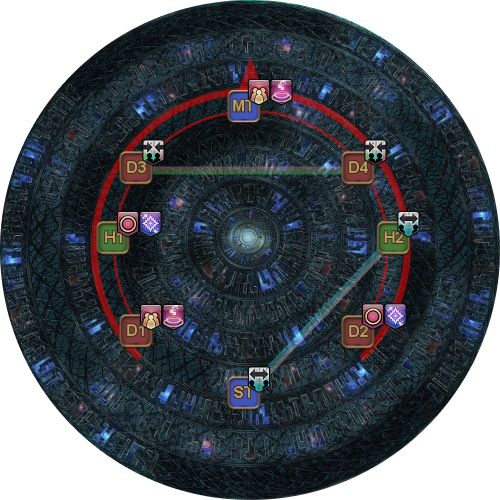 |
| 2. Preposition to prepare for the first set of towers.
| 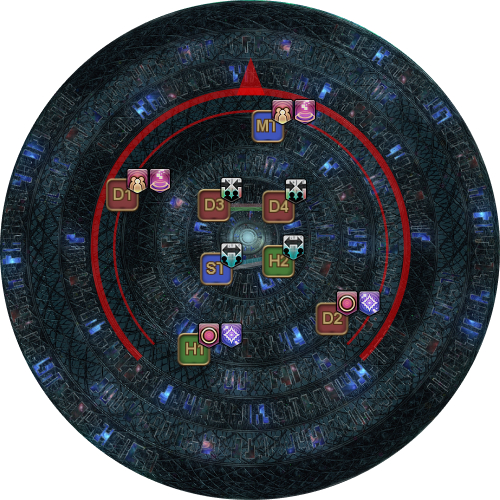 |
| 3. When the towers appear, the players with Critical Overflow The players with the tethers stay inside the Omega's target circle, and orient themselves to prepare to move. The tether players wait for the the Nisis to be in position before moving out. | 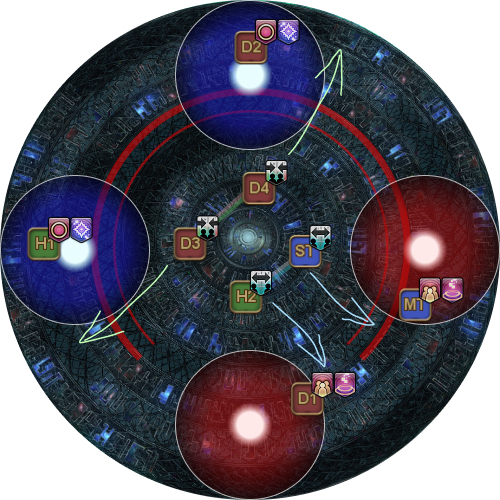 |
First, second, third iterations
For brevity’s sake, we will only display the relevant debuffs, and just the first iteration.
The second and third iterations are simply a repeat (with everyone resolving different debuffs each time).
| 4. Pair up and move to your towers.
Note the following:
| 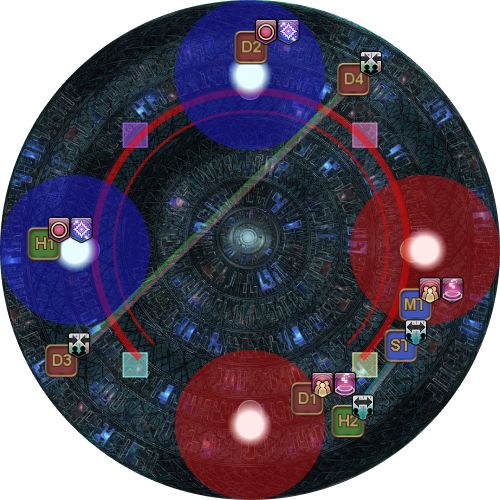 |
| 5. The first set of tethers manifest. Towers, Critical Overflow Bugs
| 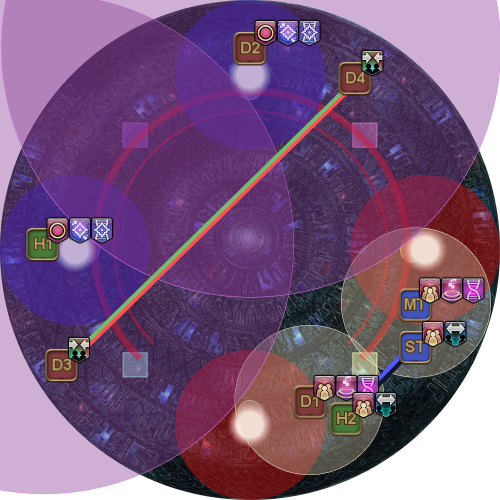 |
| 6. Wait a split second before passing Critical Underflow The players who were at the Critical Overflow Blue-tethered players also break their tether in the process. |  |
| 7. Red/green tethered players move together to break their tether. Avoid the explosions from Critical Underflow | 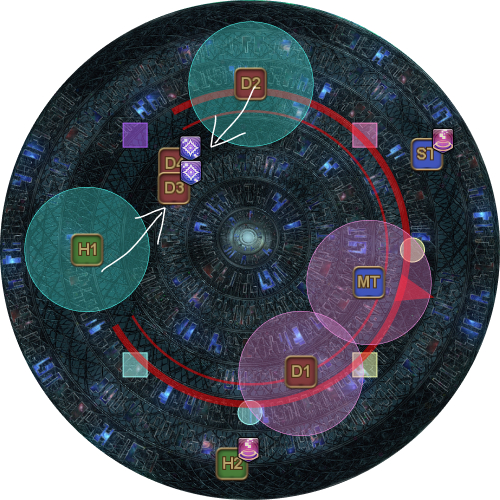 |
All players rotate their roles for the next iteration, and repeat the loop.
Fourth (final) iteration
There are two key differences for the final iteration:
- Players with Local Regression
 will join the Critical Synchronizations
will join the Critical Synchronizations  instead of getting hit by Critical Overflow
instead of getting hit by Critical Overflow  and will break first.
and will break first. - Players will not pass Critical Underflow
 and Critical Performance
and Critical Performance  .
.
Also, because all players have gone through all other roles, they have the Debugger buffs that prevent them from receiving Critical Underflow Bug and Critical Performance Bug again (the Nisis).
Thus, this final set of towers is free movement, as the Nisis will not be passed, even if players bump into one another.
| 8. Pair up and move to your towers.
| 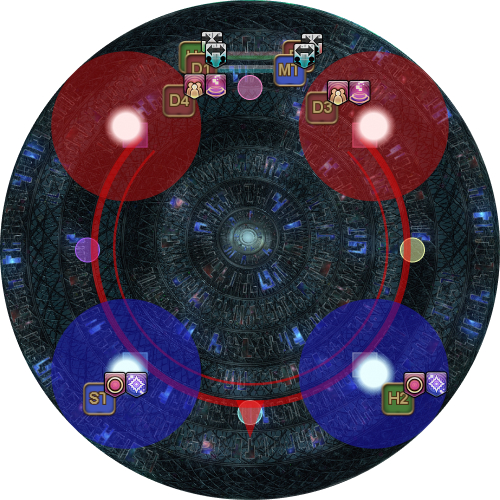 |
| 9. The last set of tethers manifest. Latent Defect, Towers, Critical Overflow Bugs This should immediately break the red/green tethers- break them if they have not. |  |
| 10. Do not pass Critical Underflow Blue-tethered players break their tether. | 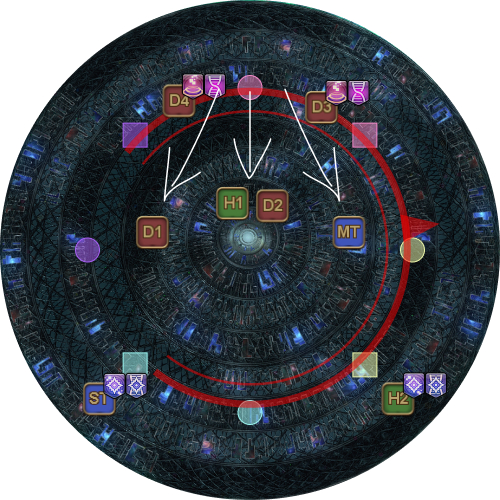 |
| 11. Avoid the explosions from Critical Underflow | 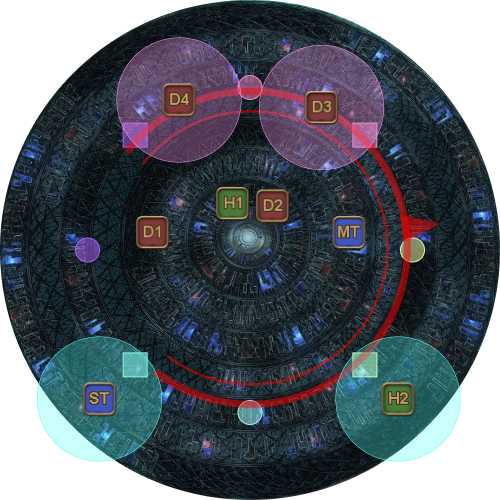 |
| 12. All players have resolved their debuffs, and there are no more bugs remaining. Omega will cast Critical Error, which deals heavy raid-wide damage, and applies a fresh Critical Overflow Bug on all players, which will get blocked by everybody's Overflow Debugger buff. | 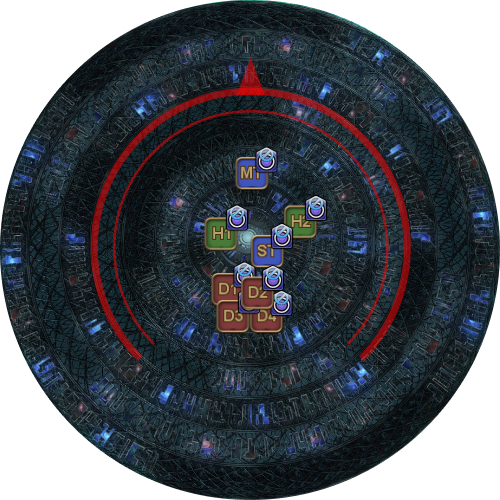 |
Oversampled Wave Cannon
Omega will teleport to the middle and face north.
Monitors will appear on Omega’s, and on three random player’s left-hand or right-hand side. For each of the four monitors (Omega and the three players), two random players on the monitor’s side will be hit with an AoE.
The party needs to arrange themselves such that all monitors hit exactly two players each.
[Click to Expand] Oversampled Wave Cannon Loading
 | Preparing oversampled wave cannon, which will fire in the direction of designated player when this effect expires. Monitors will appear on the player's left-hand or right-hand side (never the front or back). When the mechanic resolves, two random players on the side with the monitors will be hit with an AoE. If there are fewer than two players, then a random player (from anywhere) is selected for each player missing instead. |
PF currently resolves this using Astoh’s strat (アスト式), but with a different lineup order.
| 1. Line up, north-to-south:
| 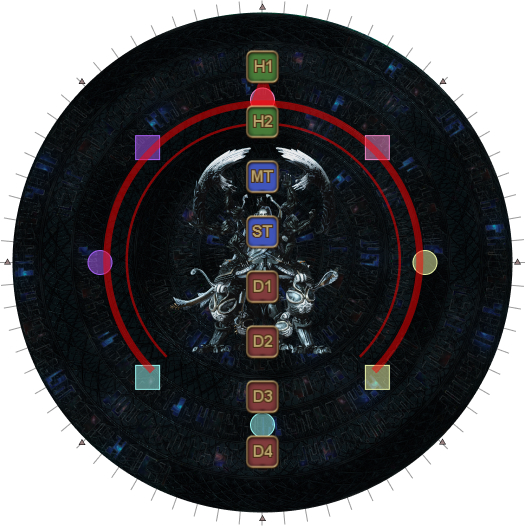 |
| 2. Omega will ready Oversampled Wave Cannon (monitors), facing directly east or west. Three random players will also get their own set of monitors. Resolve them as follows, with all three monitor players on the other side of Omega's monitors. The player positions are not particularly strict, so long as:
| |
| Omega's monitors face west | Omega's monitors face east |
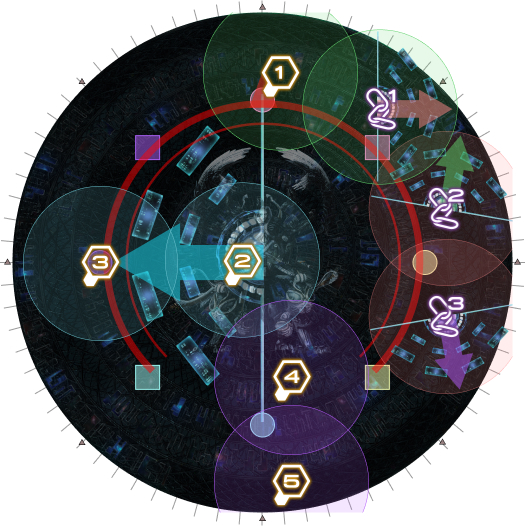 | 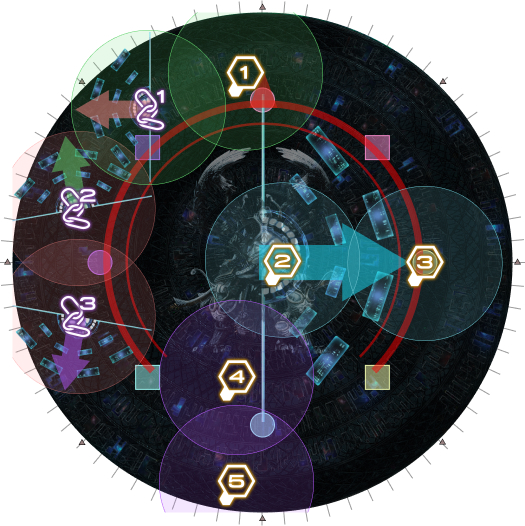 |
| A common error is accidentally clipping the non-monitor 3 player. To help prevent this:
Note that it is far easier for non-monitor players to adjust to the monitor players as needed. | |
After the Oversampled Wave Cannons resolve, Omega will then cast Ion Efflux as the hard enrage for this phase.
Frequently Asked Questions
[Local Regression] Why do the Local Regression players not stand with the Critical Overflows in the final iteration?
| Omega casts Critical Error at the end of Hello, World. Critical Error isn't just raidwide damage- Critical Error also gives all players a new Critical Overflow Bug. However, because all players have the Critical Overflow Debugger buff from resolving Critical Overflow earlier, this additional Critical Overflow Bug will be blocked. The Local Regression players at the fourth set of towers are the players that originally started with Critical Overflow Bug with the first tower, so they already have the Critical Overflow Debugger buff from then. If they stayed with the Critical Overflow Bug players in the final iteration, their Critical Overflow Debugger buffs would get consumed at the fourth towers, and as a result, they won't have the Critical Overflow Debugger buff when Omega casts Critical Error, and will get another round of Critical Overflow Bugs. These Critical Overflow Bugs will resolve together with Oversampled Wave Cannon, making Oversampled Wave Cannon impossible to resolve. |
[Oversampled Wave Cannon] Why are the healers north-most? Doesn't putting healers south-most guarantee the southern spot goes to a ranged?
Putting all four ranged players south guarantees that the southern player is a ranged, thus providing full melee uptime even in the scenario where all three monitor players are ranged, but the chances of this happening are 1/14. Putting healers at the north side means that both extremeties will have ranged players in the average case, which allows them to go all the way to the edge of the arena to give the other players more room for error, the north-most monitor player in particular. That being said, doing so means that a melee may have to disconnect from the boss in the worst case scenario, but this is an acceptable scenario given its likelihood. |
[Oversampled Wave Cannon] Are two of the monitor players supposed to be angled slightly up and down as shown in the diagram?
| Astoh's original diagram had those players look exactly East/West horizontally, and that's still fine and a workable strat. However, the problem with going horizontally is that if you're off by a little bit, there's a chance you accidentally clip the player on the far East/West (marked "3"). It doesn't help that Omega in the center is blocking your view of that player. One of the advantages of Astoh's strat is that each monitor player can clearly see the two other players they are supposed to hit with their monitors (without Omega in the way). Tilting up/down a little gives you additional margin of error to not hit the player at "3"- you can tilt as much as you want, so long as you still hit the two people you're supposed to (who aren't blocked by Omega). |
Troubleshooting
[Cascading Latent Defect/Latent Performance Defect] Why did we wipe to this even though we took the towers correctly?
| This is the result of Cascading Latent Defect or Latent Performance Defect expiring without getting cleansed. This means that either:
Taking the towers gives players a 10-second Cascading Latent Defect or Latent Performance Defect debuffs, which need to be cleaned by the appropriate Bug (the Nisis) debuffs by having them expire before the Defects. The timeline for each loop looks like this:
Since the Nisi debuffs last 27 seconds and must expire before the Defects do, this means you have a 3-4 second window after towers resolve to pass Nisis (Note: not necessarily break tethers!) for the Nisis to expire in time to cleanse the next tower's Defects. If you miss this window, your Nisi will not expire in time to cleanse the Defects before they explode and wipe the raid. |
[Oversampled Wave Cannon] A Critical Overflow AoE went off during monitors! What happened?
| Critical Error has an additional effect besides just raid-wide damage- it gives all party members a Critical Overflow Bug debuff. However, in normal cases, all party members would have the Overflow Debugger buff on them from resolving Critical Error previously. This buff is lost if the player dies. Thus, if a player that has already resolved their Critical Overflow Bug dies and is raised, Critical Error will give them a fresh copy of Critical Overflow Bug, which just so happens to resolve in 21 seconds, which is also when Oversampled Wave Cannon resolves. |